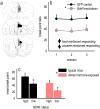Prefrontal cortical BDNF: A regulatory key in cocaine- and food-reinforced behaviors
- PMID: 26923993
- PMCID: PMC4913044
- DOI: 10.1016/j.nbd.2016.02.021
Prefrontal cortical BDNF: A regulatory key in cocaine- and food-reinforced behaviors
Abstract
Brain-derived neurotrophic factor (BDNF) affects synaptic plasticity and neural structure and plays key roles in learning and memory processes. Recent evidence also points to important, yet complex, roles for BDNF in rodent models of cocaine abuse and addiction. Here we examine the role of prefrontal cortical (PFC) BDNF in reward-related decision making and behavioral sensitivity to, and responding for, cocaine. We focus on BDNF within the medial and orbital PFC, its regulation by cocaine during early postnatal development and in adulthood, and how BDNF in turn influences responding for drug reinforcement, including in reinstatement models. When relevant, we draw comparisons and contrasts with experiments using natural (food) reinforcers. We also summarize findings supporting, or refuting, the possibility that BDNF in the medial and orbital PFC regulate the development and maintenance of stimulus-response habits. Further investigation could assist in the development of novel treatment approaches for cocaine use disorders.
Keywords: Addiction; Goal-directed; Instrumental; Operant; Orbitofrontal; Prelimbic; Review.
Copyright © 2016 Elsevier Inc. All rights reserved.
Conflict of interest statement
The authors report no conflicts of interest.
Figures


Similar articles
-
The Medial Orbitofrontal Cortex Regulates Sensitivity to Outcome Value.J Neurosci. 2016 Apr 20;36(16):4600-13. doi: 10.1523/JNEUROSCI.4253-15.2016. J Neurosci. 2016. PMID: 27098701 Free PMC article.
-
Multiple faces of BDNF in cocaine addiction.Behav Brain Res. 2015 Feb 15;279:240-54. doi: 10.1016/j.bbr.2014.11.018. Epub 2014 Nov 15. Behav Brain Res. 2015. PMID: 25449839 Free PMC article. Review.
-
Early-life cocaine interferes with BDNF-mediated behavioral plasticity.Learn Mem. 2014 Apr 15;21(5):253-7. doi: 10.1101/lm.033290.113. Learn Mem. 2014. PMID: 24737916 Free PMC article.
-
Action-Outcome Expectancies Require Orbitofrontal Neurotrophin Systems in Naïve and Cocaine-Exposed Mice.Neurotherapeutics. 2020 Jan;17(1):165-177. doi: 10.1007/s13311-019-00752-1. Neurotherapeutics. 2020. PMID: 31218603 Free PMC article.
-
Synaptic Cytoskeletal Plasticity in the Prefrontal Cortex Following Psychostimulant Exposure.Traffic. 2015 Sep;16(9):919-40. doi: 10.1111/tra.12295. Epub 2015 Jun 1. Traffic. 2015. PMID: 25951902 Free PMC article. Review.
Cited by
-
Adolescent Corticosterone and TrkB Pharmaco-Manipulations Sex-Dependently Impact Instrumental Reversal Learning Later in Life.Front Behav Neurosci. 2017 Dec 7;11:237. doi: 10.3389/fnbeh.2017.00237. eCollection 2017. Front Behav Neurosci. 2017. PMID: 29270114 Free PMC article.
-
Vagus Nerve Stimulation (VNS) Modulates Synaptic Plasticity in the Infralimbic Cortex via Trk-B Receptor Activation to Reduce Drug-Seeking in Male Rats.J Neurosci. 2024 Jun 5;44(23):e0107242024. doi: 10.1523/JNEUROSCI.0107-24.2024. J Neurosci. 2024. PMID: 38719446 Free PMC article.
-
Brain-derived neurotrophic factor and glutathione peroxidase as state biomarkers in alcohol use disorder patients undergoing detoxification.Medicine (Baltimore). 2020 Apr;99(17):e19938. doi: 10.1097/MD.0000000000019938. Medicine (Baltimore). 2020. PMID: 32332675 Free PMC article.
-
Low-Intensity Focused Ultrasound Stimulation Ameliorates Working Memory Dysfunctions in Vascular Dementia Rats via Improving Neuronal Environment.Front Aging Neurosci. 2022 Feb 21;14:814560. doi: 10.3389/fnagi.2022.814560. eCollection 2022. Front Aging Neurosci. 2022. PMID: 35264943 Free PMC article.
-
Reduced cue-induced reinstatement of cocaine-seeking behavior in Plcb1 +/- mice.Transl Psychiatry. 2021 Oct 11;11(1):521. doi: 10.1038/s41398-021-01396-6. Transl Psychiatry. 2021. PMID: 34635637 Free PMC article.
References
-
- Atwal JK, Massie B, Miller FD, Kaplan DR. The TrkB-Shc site signals neuronal survival and local axon growth via MEK and P13-kinase. Neuron. 2000;27(2):265–277. - PubMed
Publication types
MeSH terms
Substances
Grants and funding
LinkOut - more resources
Full Text Sources
Other Literature Sources
Miscellaneous

